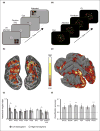Functions of the human frontoparietal attention network: Evidence from neuroimaging
- PMID: 27398396
- PMCID: PMC4936532
- DOI: 10.1016/j.cobeha.2014.08.003
Functions of the human frontoparietal attention network: Evidence from neuroimaging
Abstract
Human frontoparietal cortex has long been implicated as a source of attentional control. However, the mechanistic underpinnings of these control functions have remained elusive due to limitations of neuroimaging techniques that rely on anatomical landmarks to localize patterns of activation. The recent advent of topographic mapping via functional magnetic resonance imaging (fMRI) has allowed the reliable parcellation of the network into 18 independent subregions in individual subjects, thereby offering unprecedented opportunities to address a wide range of empirical questions as to how mechanisms of control operate. Here, we review the human neuroimaging literature that has begun to explore space-based, feature-based, object-based and category-based attentional control within the context of topographically defined frontoparietal cortex.
Figures



References
-
- Posner MI, Petersen SE. The attention system of the human brain. Annu Rev Neurosci. 1990;13:25–42. - PubMed
-
- Kastner S, Pinsk MA. Visual attention as a multilevel selection process. Cogn Affect Behav Neurosci. 2004;4:483–500. - PubMed
-
- Kastner S, Pinsk MA, De Weerd P, Desimone R, Ungerleider LG. Increased activity in human visual cortex during directed attention in the absence of visual stimulation. Neuron. 1999;22:751–761. - PubMed
-
- Moore T, Armstrong KM. Selective gating of visual signals by microstimulation of frontal cortex. Nature. 2003;421:370–373. - PubMed
Grants and funding
LinkOut - more resources
Full Text Sources
Other Literature Sources
